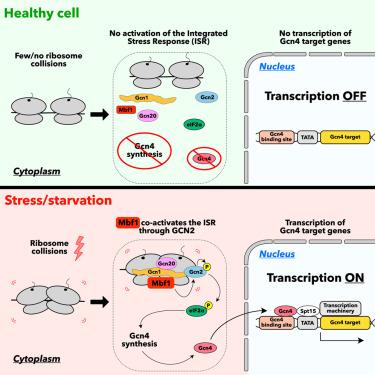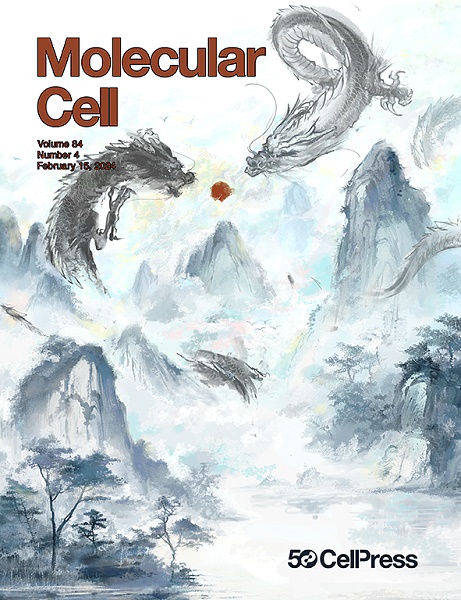碰撞核糖体上的综合应激反应需要多蛋白桥接因子1的强力激活
IF 14.5
1区 生物学
Q1 BIOCHEMISTRY & MOLECULAR BIOLOGY
引用次数: 0
摘要
在酵母中,多蛋白桥接因子 1(Mbf1)通过介导一般转录机制与该过程的关键效应物 Gcn4 之间的直接相互作用,被认为在综合应激反应(ISR)中起着转录辅激活剂的作用。然而,越来越多的证据表明,Mbf1(及其人类同源物 EDF1)被招募到碰撞核糖体上,而核糖体是 ISR 的已知激活因子。在本研究中,我们将 Mbf1 这些看似不同的功能联系起来。我们的生化和结构分析表明,Mbf1 通过与碰撞核糖体相互作用来介导 Gcn2 激活,从而发挥 ISR 核心因子的功能。我们进一步发现,Mbf1 并不充当 Gcn4 的转录辅激活因子。相反,Mbf1 是压力诱导的真核启动因子 2α(eIF2α)最佳磷酸化和 GCN4 翻译下游去抑制所必需的。总之,我们的数据证实了 Mbf1 在 ISR 信号转导中的功能,它是应激诱导的核糖体碰撞的直接传感器。本文章由计算机程序翻译,如有差异,请以英文原文为准。

Multiprotein bridging factor 1 is required for robust activation of the integrated stress response on collided ribosomes
In yeast, multiprotein bridging factor 1 (Mbf1) has been proposed to function in the integrated stress response (ISR) as a transcriptional coactivator by mediating a direct interaction between general transcription machinery and the process’s key effector, Gcn4. However, mounting evidence has demonstrated that Mbf1 (and its human homolog EDF1) is recruited to collided ribosomes, a known activator of the ISR. In this study, we connect these otherwise seemingly disparate functions of Mbf1. Our biochemical and structural analyses reveal that Mbf1 functions as a core ISR factor by interacting with collided ribosomes to mediate Gcn2 activation. We further show that Mbf1 serves no role as a transcriptional coactivator of Gcn4. Instead, Mbf1 is required for optimal stress-induced eukaryotic initiation factor 2α (eIF2α) phosphorylation and downstream de-repression of GCN4 translation. Collectively, our data establish that Mbf1 functions in ISR signaling by acting as a direct sensor of stress-induced ribosome collisions.
求助全文
通过发布文献求助,成功后即可免费获取论文全文。
去求助
来源期刊

Molecular Cell
生物-生化与分子生物学
CiteScore
26.00
自引率
3.80%
发文量
389
审稿时长
1 months
期刊介绍:
Molecular Cell is a companion to Cell, the leading journal of biology and the highest-impact journal in the world. Launched in December 1997 and published monthly. Molecular Cell is dedicated to publishing cutting-edge research in molecular biology, focusing on fundamental cellular processes. The journal encompasses a wide range of topics, including DNA replication, recombination, and repair; Chromatin biology and genome organization; Transcription; RNA processing and decay; Non-coding RNA function; Translation; Protein folding, modification, and quality control; Signal transduction pathways; Cell cycle and checkpoints; Cell death; Autophagy; Metabolism.
 求助内容:
求助内容: 应助结果提醒方式:
应助结果提醒方式:


